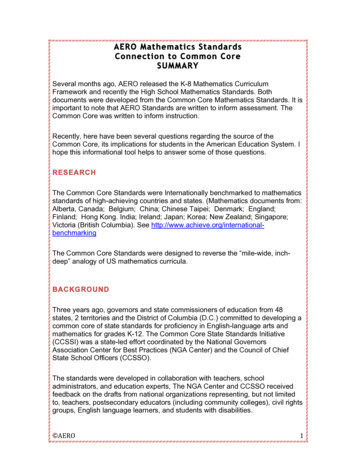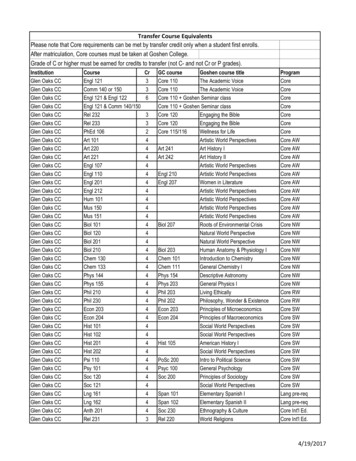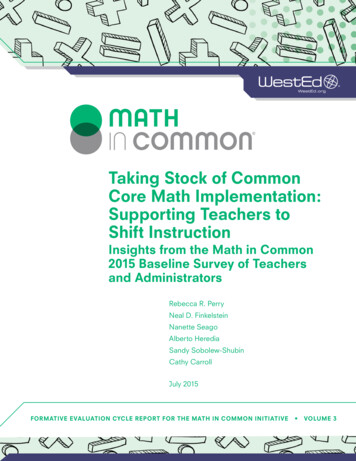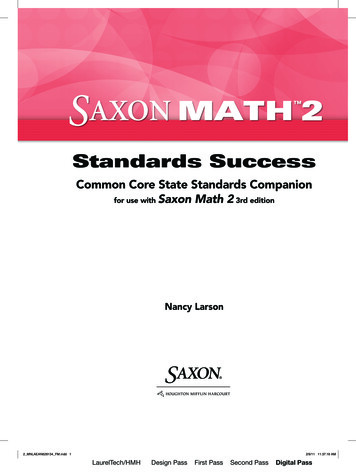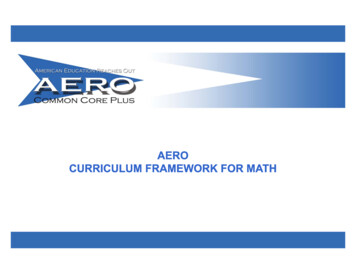
Transcription
IntroductionThe AERO Curriculum Framework for Mathematics builds on the Common Core State Standards for Mathematics. The standardsin this UPDATED Framework are the culmination of our effort to fulfill the need for pre‐kindergarten through grade 12standards aligned to the internationally benchmarked standards.In 2009, prior to the Council of Chief State School Officers (CCSSO) and the National Governors Association Center for BestPractice (NGA) standards development initiative, AERO revised their existing Standards. In 2010, The Common Core StateStandards for Mathematics were released. AERO, then, released a crosswalk to demonstrate the similarities and differences inthe documents. Recently there have been requests to up date the standards to reflect the Standards.As specified by CCSSO and NGA, these standards are (1) research‐ and evidence‐based, (2) aligned with college and workexpectations, (3) rigorous, and (4) internationally benchmarked. The development of these standards began with research‐based learning progressions detailing what is known today about how students’ mathematical knowledge, skills, andunderstanding develop over time. Standards are intended to be a living work: as new and better evidence emerges, thestandards will be revised accordingly.The standards do not dictate curriculum or teaching methods. In fact, standards from different domains and clusters aresometimes closely related. What students can learn at any particular grade level depends upon what they have learned before.Ideally then, each standard in this document might have been phrased in the form, “Students who already know should nextcome to learn .” But at present this approach is unrealistic—not least because existing education research cannot specify allsuch learning pathways. Of necessity therefore, grade placements for specific topics have been made on the basis of state andinternational comparisons and the collective experience and collective professional judgment of educators, researchers andmathematicians. One promise of common state standards is that over time they will allow research on learning progressionsto inform and improve the design of standards to a much greater extent than is possible today. Learning opportunities willcontinue to vary across schools and school systems, and educators should make every effort to meet the needs of individualstudents based on their current understanding.
These standards are not intended to be new names for old ways of doing business. They are a call to take the next step. It istime for states to work together to build on lessons learned from two decades of standards based reforms. It is time torecognize that standards are not just promises to our children, but promises we intend to keep. www.corestandards.org
Guiding Principles for MathematicsGuiding Principle 1: LearningMathematical ideas should be explored in ways that stimulate curiosity, create enjoyment of mathematics, and develop depthof understanding.Guiding Principle 2: TeachingAn effective mathematics program is based on a carefully designed set of content standards that are clear and specific, focused,and articulated over time as a coherent sequence.Guiding Principle 3: TechnologyTechnology is an essential tool that should be used strategically in mathematics education.Guiding Principle 4: EquityAll students should have a high quality mathematics program that prepares them for college and career.Guiding Principle 5: AssessmentAssessment of student learning in mathematics should take many forms to inform instruction and learningNCTM Principles Standards for Mathematics
AERO Mathematics StandardsUpdated 7/1/2015Progressions Pre K- 2Domain: CountingKnow number names andthe count sequence.PreKK12AERO.PK.CC.1Count verbally to 10 by ones.AERO.K.CC.1DO K 1Count to 100 by ones and bytens.AERO.K.CC.2DO K 1 ,2Count forward beginning froma given number within theknown sequence (instead ofhaving to begin at 1).AERO.1. NBT.1DO K 1 ,2Count to 120, starting at anynumber less than 120. In thisrange, read and writenumerals and represent anumber of objects with awritten numeral.AERO.2.NBT.2DO K 1Count within 1000; skip-countby 5s, 10s, and 100s.AERO.PK.CC.2Recognize the concept of justafter or just before a givennumber in the countingsequence up to 10.Count to tell the number ofobjects.AERO.PK.CC.3Identify written numerals 0-10.AERO.K.CC.3DO K 1Write numbers from 0 to 20.Represent a number ofobjects with a written numeral0-20 (with 0 representing acount of no objects)AERO.PK.CC.4Understand the relationshipbetween numbers andquantities; connect countingto cardinality.AERO.K.CC.4DO K 2Understand the relationshipbetween numbers andquantities; connect countingto cardinalityAERO.PK.CC.4a.When counting objects, saythe number names in thestandard order, pairing eachobject with one and only onenumber name and eachnumber name with one andonly one objectAERO.K.CC.4aDO K 2When counting objects, saythe number names in thestandard order, pairing eachobject with one and only onenumber name and eachnumber name with one andonly one object.AERO Mathematics Standards July 2015AERO.2.NBT.3DO K 1 ,2Read and write numbers to1000 using base-tennumerals, number names,and expanded form.1
Domain: CountingCount to tell the number ofobjects.PreKKAERO.PK.CC.4bRecognize that the lastnumber name said tells thenumber of objects counted.AERO.K.CC.4bDO K 2Understand that the lastnumber name said tells thenumber of objects counted.The number of objects is thesame regardless of theirarrangement or the order inwhich they were counted.AERO.PK.CC.4cRecognize that eachsuccessive number namerefers to a quantity that is onelarger.AERO.K.CC.4cDO K 2Understand that eachsuccessive number namerefers to a quantity that is onelarger.AERO.PK.CC.5Represent a number (0-5,then to 10) by producing a setof objects with concretematerials, pictures, and/ornumerals (with 0 representinga count of no objects).AERO.K.CC.5DO K 2Count to answer "how many?"questions about as many as20 things arranged in a line, arectangular array, or a circle,or as many as 10 things in ascattered configuration; givena number from 1-20, countout that many objects.AERO.PK.CC.6Recognize the number ofobjects in a set withoutcounting (Subitizing). (Use 05 objects)AERO Mathematics Standards July 2015122
Domain: CountingPreKK12Compare numbers.AERO.PK.CC.7Explore relationships bycomparing groups of objectsup to 10, to determine greaterthan/more or less than, andequal to/same Identifywhether the number ofobjects in one group isgreater than, less than, orequal to the number ofobjects in another group, e.g.,by using matching andcounting strategies (includesgroups with up to 5 objects).AERO.K.CC.6DO K 2Identify whether the numberof objects in one group isgreater than, less than, orequal to the number ofobjects in another group, e.g.,by using matching andcounting strategiesAERO.1.NBT.3DO K 2Compare two two-digitnumbers based on meaningsof the tens and ones digits,recording the results ofcomparisons with the symbols , , and .AERO.2.NBT.4DO K 2Compare two three-digitnumbers based on meaningsof the hundreds, tens, andones digits, using , , and symbols to record the resultsof comparisons.AERO Mathematics Standards July 2015AERO.K.CC.7DO K 1 .2Compare two numbersbetween 1 and 10 presentedas written numerals.3
Domain: Numbers in BaseTenWork with numbers 11-19 togain foundations for placevaluePreKAERO.PK.NBT.1Investigate the relationshipbetween ten ones and tenK12AERO.K.NBT.1DO K 2Compose and decomposenumbers from 11 to 19 intoten ones and some furtherones, e.g., by using objects ordrawings, and record eachcomposition or decompositionby a drawing or equation(such as 18 10 8);understand that thesenumbers are composed of tenones and one, two, three,four, five, six, seven, eight, ornine ones.AERO.1.NBT.2DO K 2Understand that the two digitsof a two-digit numberrepresent amounts of tensand ones. Understand thefollowing as special cases:AERO.2.NBT.1DO K 2Understand that the threedigits of a three-digit numberrepresent amounts ofhundreds, tens, and ones;e.g., 706 equals 7 hundreds,0 tens, and 6 ones.Understand the following asspecial cases:AERO.1.NBT.2aDO K 210 can be thought of as abundle of ten ones — called a"ten."AERO.2.NBT.1aDO K 2100 can be thought of as abundle of ten tens — called a"hundred."AERO.1.NBT.2bDO K 2The numbers from 11 to 19are composed of a ten andone, two, three, four, five, six,seven, eight, or nine ones.AERO.1.NBT.2cDO K 2The numbers 10, 20, 30, 40,50, 60, 70, 80, 90 refer toone, two, three, four, five, six,seven, eight, or nine tens(and 0 ones)AERO Mathematics Standards July 2015AERO.2.NBT.1bDO K 2The numbers 100, 200, 300,400, 500, 600, 700, 800, 900refer to one, two, three, four,five, six, seven, eight, or ninehundreds (and 0 tens and 0ones).4
Domain: Numbers in BaseTenUse place valueunderstanding andproperties of operations toadd and subtract.PreKAERO Mathematics Standards July 2015K12AERO.1.NBT.4 DO K 1 ,2 ,3Add within 100, includingadding a two-digit numberand a one-digit number, andadding a two-digit numberand a multiple of 10, usingconcrete models or drawingsand strategies based on placevalue, properties ofoperations, and/or therelationship between additionand subtraction; relate thestrategy to a written methodand explain the reasoningused. Understand that inadding two-digit numbers, oneadds tens and tens, ones andones; and sometimes it isnecessary to compose a ten.AERO.2.NBT.5DO K 1 ,2Fluently add and subtractwithin 100 using strategiesbased on place value,properties of operations,and/or the relationshipbetween addition andsubtraction.AERO.1.NBT.5DO K 2 ,3Given a two-digit number,mentally find 10 more or 10less than the number, withouthaving to count; explain thereasoning used.AERO.2.NBT.8DO K 2Mentally add 10 or 100 to agiven number 100-900, andmentally subtract 10 or 100from a given number 100-900.5
Domain: Numbers in BaseTenUse place valueunderstanding andproperties of operations toadd and subtract.PreKAERO Mathematics Standards July 2015K12AERO.1.NBT.6DO K 2 ,3Subtract multiples of 10 in therange 10-90 from multiples of10 in the range 10-90(positive or zero differences),using concrete models ordrawings and strategiesbased on place value,properties of operations,and/or the relationshipbetween addition andsubtraction; relate thestrategy to a written methodand explain the reasoningused.6
Domain: OperationsAlgebraic ThinkingRepresent and solveproblems involving additionand subtraction.PreKRepresent and solveproblems involving additionand subtraction.K12AERO.2.NBT.7DO K 2Add and subtract within 1000,using concrete models ordrawings and strategiesbased on place value,properties of operations,and/or the relationshipbetween addition andsubtraction; relate thestrategy to a written method.Understand that in adding orsubtracting three-digitnumbers, one adds orsubtracts hundreds andhundreds, tens and tens,ones and ones; andsometimes it is necessary tocompose or decompose tensor hundreds.AERO.2.NBT.6DO K 2Add up to four two-digitnumbers using strategiesbased on place value andproperties of operations.AERO.2.NBT.9DO K 3Explain why addition andsubtraction strategies work,using place value and theproperties of operations.AERO Mathematics Standards July 20157
Domain: OperationsAlgebraic ThinkingUnderstand addition, andunderstand subtraction.PreKAERO.PK.OA.1Explore addition andsubtraction with objects,fingers, mental images,drawings, sounds (e.g.,claps), acting out situations,or verbal explanations.AERO.PK.OA.2Decompose quantity (lessthan or equal to 5, then to 10)into pairs in more than oneway (e.g., by using objects ordrawings).AERO Mathematics Standards July 2015K12AERO.K.OA.1DO K 2Represent addition andsubtraction with objects,fingers, mental images,drawings, sounds (e.g.,claps), acting out situations,verbal explanations,expressions, or equations.AERO.1.OA.1DO K 2Use addition and subtractionwithin 20 to solve wordproblems involving situationsof adding to, taking from,putting together, taking apart,and comparing, withunknowns in all positions,e.g., by using objects,drawings, and equations witha symbol for the unknownnumber to represent theproblemAERO.2.OA.1DO K 2Use addition and subtractionwithin 100 to solve one- andtwo-step word problemsinvolving situations of addingto, taking from, puttingtogether, taking apart, andcomparing, with unknowns inall positions, e.g., by usingdrawings and equations witha symbol for the unknownnumber to represent theproblem.AERO.K.OA.2DO K 2Solve addition and subtractionword problems, and add andsubtract within 10, e.g., byusing objects or drawings torepresent the problem.AERO.1.OA.2DO K 2Solve word problems that callfor addition of three wholenumbers whose sum is lessthan or equal to 20, e.g., byusing objects, drawings, andequations with a symbol forthe unknown number torepresent the problem.AERO.K.OA.3DO K 2 .3Decompose numbers lessthan or equal to 10 into pairsin more than one way, e.g., byusing objects or drawings,and record eachdecomposition by a drawingor equation (e.g., 5 2 3and 5 4 1)8
Domain: OperationsAlgebraic ThinkingUnderstand addition, andunderstand subtraction.PreKKAERO.PK.OA.3For any given quantity from (0to 5, then to 10) find thequantity that must be addedto make 5, then to 10, e.g., byusing objects or drawings.AERO.K.OA.4DO K 2For any number from 1 to 9,find the number that makes10 when added to the givennumber, e.g., by using objectsor drawings, and record theanswer with a drawing orequation.AERO.K.OA.5DO K 1Fluently add and subtractwithin 5.AERO Mathematics Standards July 201512AERO.1.OA.6DO K 1 ,2Add and subtract within 20,demonstrating fluency foraddition and subtractionwithin 10. Use strategiessuch as counting on; makingten (e.g., 8 6 8 2 4 10 4 14); decomposing anumber leading to a ten (e.g.,13 - 4 13 - 3 - 1 10 - 1 9); using the relationshipbetween addition andsubtraction (e.g., knowing that8 4 12, one knows 12 - 8 4); and creating equivalentbut easier or known sums(e.g., adding 6 7 by creatingthe known equivalent 6 6 1 12 1 13).AERO.2.OA.2DO K 1Fluently add and subtractwithin 20 using mentalstrategies. By end of Grade 2,know from memory all sumsof two one-digit numbers.9
Domain: OperationsAlgebraic ThinkingUnderstand and applyproperties of operations andthe relationship betweenaddition and subtractionPreKK12AERO.1.OA.3DO K 2Apply properties of operationsas strategies to add andsubtract. Examples: If 8 3 11 is known, then 3 8 11is also known. (Commutativeproperty of addition.) To add 2 6 4, the second twonumbers can be added tomake a ten, so 2 6 4 2 10 12. (Associative propertyof addition.)AERO.1.OA.4DO K 2Understand subtraction as anunknown-addend problem.For example, subtract 10 - 8by finding the number thatmakes 10 when added to 8Add and subtract within 20.AERO Mathematics Standards July 2015AERO.1.OA.5DO K 1 ,2Relate counting to additionand subtraction (e.g., bycounting on 2 to add 2)10
Domain: OperationsAlgebraic ThinkingWork with addition andsubtraction equations.PreKK12AERO.1.OA.7DO K 3Understand the meaning ofthe equal sign, and determineif equations involving additionand subtraction are true orfalse. For example, which ofthe following equations aretrue and which are false? 6 6, 7 8 - 1, 5 2 2 5, 4 1 5 2.AERO.1.OA.8DO K 2Determine the unknownwhole number in an additionor subtraction equationrelating three whole numbers.For example, determine theunknown number that makesthe equation true in each ofthe equations 8 ? 11, 5 - 3, 6 6 .AERO Mathematics Standards July 201511
Domain: OperationsAlgebraic ThinkingWork with equal groups ofobjects to gain foundations formultiplication.PreKK12AERO.2.OA.3DO K 2Determine whether a group ofobjects (up to 20) has an oddor even number of members,e.g., by pairing objects orcounting them by 2s; write anequation to express an evennumber as a sum of two equaladdends.AERO.2.OA.4DO K 2Use addition to find the totalnumber of objects arranged inrectangular arrays with up to5 rows and up to 5 columns;write an equation to expressthe total as a sum of equaladdends.AERO Mathematics Standards July 201512
Domain: Measurement andDataDescribe and comparemeasurable attributesPreKAERO.PK.MD.1Describe measurableattributes of objects, such aslength or weight.Measure lengths indirectlyand by iterating length unitsAERO Mathematics Standards July 2015KAERO.K.MD.1DO K 2Describe measurableattributes of objects, such aslength or weight. Describeseveral measurable attributesof a single object12AERO.1.MD.1DO K 2 ,3Order three objects by length;compare the lengths of twoobjects indirectly by using athird objectAERO.2.MD.1DO K 1Measure the length of anobject by selecting and usingappropriate tools such asrulers, yardsticks, metersticks, and measuring tapes.AERO.1.MD.2DO K 1 ,2Express the length of anobject as a whole number oflength units, by laying multiplecopies of a shorter object (thelength unit) end to end;understand that the lengthmeasurement of an object isthe number of same-sizelength units that span it withno gaps or overlaps. Limit tocontexts where the objectbeing measured is spannedby a whole number of lengthunits with no gaps or overlapsAERO.2.MD.2DO K 2 ,3Measure the length of anobject twice, using lengthunits of different lengths forthe two measurements;describe how the twomeasurements relate to thesize of the unit chosen.AERO.2.MD.3DO K 2Estimate lengths using unitsof inches, feet, centimeters,and meters.AERO.2.MD.4DO K 1 , 2Measure to determine howmuch longer one object isthan another, expressing thelength difference in terms of astandard length unit.13
Domain: Measurement andDataPreKKRelate addition andsubtraction to length12AERO.2.MD.5DO K 2Use addition and subtractionwithin 100 to solve wordproblems involving lengthsthat are given in the sameunits, e.g., by using drawings(such as drawings of rulers)and equations with a symbolfor the unknown number torepresent the problem.AERO.2.MD.6DO K 1 ,2Represent whole numbers aslengths from 0 on a numberline diagram with equallyspaced points correspondingto the numbers 0, 1, 2, ., andrepresent whole-numbersums and differences within100 on a number linediagram.AERO.PK.MD.2Directly compare two objectswith a measurable attribute incommon, using words suchas longer/shorter;heavier/lighter; ortaller/shorter.AERO Mathematics Standards July 2015AERO.K.MD.2DO K 2Directly compare two objectswith a measurable attribute incommon, to see which objecthas "more of"/"less of" theattribute, and describe thedifference. For example,directly compare the heightsof two children and describeone child as taller/shorter.14
Domain: Measurement andDataPreKKTell and write time.Classify objects and count thenumber of objects in eachcategory.AERO.PK.MD.3Sort objects into givencategoriesRepresent and interpret data.AERO.PK.MD.4Compare categories usingwords such as greaterthan/more, less than, andequal to/same.AERO Mathematics Standards July 201512AERO.1.MD.3DO K 1Tell and write time in hoursand half-hours using analogand digital clocks.AERO.2.MD.7DO K 1Tell and write time fromanalog and digital clocks tothe nearest five minutes,using a.m. and p.m.AERO.2.MD.8DO K 2Solve word problemsinvolving dollar bills, quarters,dimes, nickels, and pennies,using and symbolsappropriately. Example: If youhave 2 dimes and 3 pennies,how many cents do youhave?AERO.1.MD.4DO K 2 ,3Organize, represent, andinterpret data with up to threecategories; ask and answerquestions about the totalnumber of data points, howmany in each category, andhow many more or less are inone category than in another.AERO.2.MD.9DO K 2Generate measurement databy measuring lengths ofseveral objects to the nearestwhole unit, or by makingrepeated measurements ofthe same object. Show themeasurements by making aline plot, where the horizontalscale is marked off in wholenumber units.AERO.K.MD.3DO K 1 ,2Classify objects into givencategories; count thenumbers of objects in eachcategory and sort thecategories by count.15
Domain: GeometryPreKKRepresent and interpret data.Identify and describe shapes12AERO.2.MD.10DO K 2Draw a picture graph and abar graph (with single-unitscale) to represent a data setwith up to four categories.Solve simple put-together,take-apart, and compareproblems1 using informationpresented in a bar graph.AERO.PK.G.1Match like (congruent andsimilar) shapes.AERO.K.G.1DO K 1 ,2Describe objects in theenvironment using names ofshapes, and describe therelative positions of theseobjects using terms such asabove, below, beside, in frontof, behind, and next toAERO.PK.G.2Group the shapes byattributes.AERO.K.G.2DO K 1Correctly name shapesregardless of theirorientations or overall size.AERO.PK.G.3Correctly name shapes(regardless of theirorientations or overall size).AERO.K.G.3DO K 1Identify shapes as twodimensional (lying in a plane,"flat") or three-dimensional("solid").AERO Mathematics Standards July 201516
Domain: GeometryAnalyze, compare, create,and compose shapes.PreKK12AERO.PK.G.4Describe three-dimensionalobjects using attributes.AERO.K.G.4DO K 2 ,3Analyze and compare twoand three-dimensionalshapes, in different sizes andorientations, using informallanguage to describe theirsimilarities, differences, parts(e.g., number of sides andvertices/"corners") and otherattributes (e.g., having sidesof equal length).AERO.1.G.1DO K 2Distinguish between definingattributes (e.g., triangles areclosed and three-sided)versus non-defining attributes(e.g., color, orientation,overall size); build and drawshapes to possess definingattributes.AERO.2.G.1DO K 1 , 2Recognize and draw shapeshaving specified attributes,such as a given number ofangles or a given number ofequal faces.1 Identifytriangles, quadrilaterals,pentagons, hexagons, andcubes.AERO.PK.G.5Describe three-dimensionalobjects using attributes.AERO.K.G.5DO K 2 ,3Model shapes in the world bybuilding shapes fromcomponents (e.g., sticks andclay balls) and drawingshapes.AERO.PK.G.6Compose and describestructures using threedimensional shapes.Descriptions may includeshape attributes, relativeposition, etcAERO.K.G.6DO K 2 ,3Compose simple shapes toform larger shapes. Forexample, "Can you join thesetwo triangles with full sidestouching to make a rectangle?AERO.1.G.2DO K 2 ,3Compose two-dimensionalshapes (rectangles, squares,trapezoids, triangles, halfcircles, and quarter-circles) orthree-dimensional shapes(cubes, right rectangularprisms, right circular cones,and right circular cylinders) tocreate a composite shape,and compose new shapesfrom the composite shapeAERO Mathematics Standards July 201517
Domain: GeometryPreKAnalyze, compare, create,and compose shapes.AERO Mathematics Standards July 2015K12AERO.1.G.3DO K 1 ,2Partition circles andrectangles into two and fourequal shares, describe theshares using the wordshalves, fourths, and quarters,and use the phrases half of,fourth of, and quarter of.Describe the whole as two of,or four of the shares.Understand for theseexamples that decomposinginto more equal sharescreates smaller shares.AERO.2.G.2DO K 2Partition a rectangle into rowsand columns of same-sizesquares and count to find thetotal number of them.AERO.2.G.3DO K 2 ,3Partition circles andrectangles into two, three, orfour equal shares, describethe shares using the wordshalves, thirds, half of, a thirdof, etc., and describe thewhole as two halves, threethirds, four fourths. Recognizethat equal shares of identicalwholes need not have thesame shape.18
MathematicalPractices1. Make sense ofproblems andpersevere in solvingthem.PreK/K1Use both verbal and nonverbal means,these students begin to explain tothemselves and others the meaning of aproblem, look for ways to solve it, anddetermine if their thinking makes senseor if another strategy is needed.Explain to themselves the meaning of aproblem and look for ways to solve it.May use concrete objects or picturesto help them conceptualize and solveproblems.Are willing to try other approaches.2In second grade, students realize that doingmathematics involves solving problems anddiscussing how they solved them.Students explain to themselves the meaningof a problem and look for ways to solve it.They may use concrete objects or picturesto help them conceptualize and solveproblems.They may check their thinking by askingthemselves, “Does this make sense?” Theymake conjectures about the solution and planout a problem-solving approach.2. Reason abstractlyand quantitatively.Begin to use numerals to representspecific amount (quantity)Recognize that a number represents aspecific quantity.Younger students recognize that a numberrepresents a specific quantity.Begin to draw pictures, manipulateobjects, use diagrams or charts, etc. toexpress quantitative ideas such as ajoining situationConnect the quantity to writtensymbols.They connect the quantity to writtensymbols.Create a representation of a problemwhile attending to the meanings of thequantities.Quantitative reasoning entails creating arepresentation of a problem while attendingto the meanings of the quantities.Begin to understand how symbols ( , -, ) are used to represent quantitativeideas in a writtenformat.AERO Mathematics Standards July 2015Second graders begin to know and usedifferent properties of operations and alsorelate addition and subtraction to length.19
MathematicalPractices3. Construct viablearguments andcritique thereasoning of others.PreK/KBegin to clearly express, explain,organize and consolidate their maththinking using both verbal and writtenrepresentations.Begin to learn how to express opinions,become skillful at listening to others,describe their reasoning and respond toothers’ thinking and reasoning.12Construct arguments using concretereferents, such as objects, pictures,drawings, and actions.Construct arguments using concretereferents, such as objects, pictures,drawings, and actions.Explain their own thinking and listen toothers’ explanations.Explain their own thinking and listen toothers’ explanations.Decide if the explanations make senseand ask questions.Decide if the explanations make sense andask appropriate questions.Experiment with representing problemsituations in multiple ways includingnumbers, words (mathematicallanguage), drawing pictures, usingobjects, acting out, making a chart orlist, creating equations, etc.Experiment with representing problemsituations in multiple ways including numbers,words (mathematical language), drawingpictures, using objects, acting out, making achart or list, creating equations, etc.Begin to develop the ability to reasonand analyze situations as they considerquestions such as, “Are you sure.?” ,“Do you think that would happen allthe time.?”, and “I wonder why.?”4. Model withmathematics.Begin to experiment with representingreal-life problem situations in multipleways such as with numbers, words(mathematical language), drawings,objects, acting out, charts, lists, andnumber sentences.Connect the different representationsand explain the connections.Connect the different representations andexplain the connections.Able to use all representations as needed.AERO Mathematics Standards July 201520
MathematicalPractices5. Use appropriatetools strategically.PreK/KBegin to explore various tools and usethem to investigate mathematicalconcepts. Through multipleopportunities to examine materials1Decide when certain tools might behelpful when solving a mathematicalproblem. For example , first gradersdecide it might be best to use coloredchips to model an addition problem.Consider the available tools (includingestimation) when solving a mathematicalproblem and decide when certain tools mightbe better suited. For example, secondgraders may decide to solve a problem bydrawing a picture rather than writing anequation.Use clear and precise language in theirdiscussions with others and when theyexplain their own reasoning.Use clear and precise language in theirdiscussions with othersExperiment and use both concretematerials (e.g. 3- dimensional solids,connecting cubes, ten frames, numberbalances) and technological materials(e.g., virtual manipulatives, calculators,interactive websites) to exploremathematical concepts.6. Attend toprecision.Begin to express their ideas andreasoning using words.Begin to describe their actions andstrategies more clearly, understand anduse grade-level appropriate vocabularyaccurately, and begin to give preciseexplanations and reasoning regardingtheir process of finding solutions.AERO Mathematics Standards July 20152Explain their own reasoning.21
MathematicalPractices7. Look for and makeuse of structure.(Deductive Reasoning)8. Look for andexpress regularity inrepeated reasoning.(Inductive Reasoning)PreK/K12Begin to look for patterns andstructures in the number system andother areas of mathematics.Begin to discern a pattern or structure.For example, if students recognize 12 3 15, then they also know 3 12 15. (Commutative property of addition.)To add 4 6 4, the first twonumbers can be added to make a ten,so 4 6 4 10 4 14.Look for patterns. For example , they adoptmental math strategies based on patterns(making ten, fact families, doubles).Begin to notice repetitive actions ingeometry, counting, comparing, etc.Notice repetitive actions in countingand computation, etc.Notice repetitive actions in counting andcomputation, etc.Continually check their work by askingthemselves, “Does this make sense?”Look for shortcuts, when adding andsubtracting, such as rounding up and thenadjusting theanswer to compensate for the rounding.Continually check their work by askingthemselves, “Does this make sense?”AERO Mathematics Standards July 201522
AERO Mathematics StandardsUpdated 7/1/2015Progressions 3-5Domain: Number and Operations inBase TenUse place value understanding andproperties of operations to performmulti-digit arithmetic345AERO. 3.NBT.1DO K 1Use place value
Introduction The AERO Curriculum Framework for Mathematics builds on the Common Core State Standards for Mathematics.The standards in this UPDATED Framework are the culmination of our effort to fulfill the need for pre‐kindergarten through grade 12 standards aligned to the internationally benchmarked standards. In 2009, prior to the Council of Chief State School Officers (CCSSO) and the .
